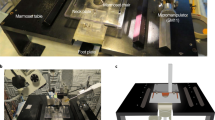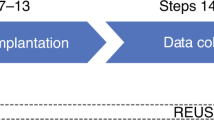Abstract
Intracellular recordings are routinely used to study the synaptic and intrinsic properties of neurons in vitro. A key requirement for these recordings is a mechanically very stable preparation; thus their use in vivo had been limited previously to head-restrained animals. We have recently demonstrated that anchoring the electrode rigidly in place with respect to the skull provides sufficient stabilization for long-lasting, high-quality whole-cell recordings in awake, freely moving rats. This protocol describes our procedure in detail, adds specific instructions for targeting hippocampal CA1 pyramidal neurons and updates it with changes that facilitate patching and improve the success rate. The changes involve combining a standard, nonhead-mounted micromanipulator with a gripper to firmly hold the recording pipette during the anchoring process then gently release it afterwards. The procedure from the beginning of surgery to the end of a recording takes ∼5 h. This technique allows new studies of the mechanisms underlying neuronal integration and cellular/synaptic plasticity in identified cells during natural behaviors.
This is a preview of subscription content, access via your institution
Access options
Subscribe to this journal
Receive 12 print issues and online access
$259.00 per year
only $21.58 per issue
Buy this article
- Purchase on Springer Link
- Instant access to full article PDF
Prices may be subject to local taxes which are calculated during checkout




Similar content being viewed by others
References
Hubel, D.H. Single unit activity in striate cortex of unrestrained cats. J. Physiol. 147, 226–238 (1959).
O'Keefe, J. & Dostrovsky, J. The hippocampus as a spatial map. Preliminary evidence from unit activity in the freely-moving rat. Brain Res. 34, 171–175 (1971).
Yokota, T., Reeves, A.G. & MacLean, P.D. Differential effects of septal and olfactory volleys on intracellular responses of hippocampal neurons in awake, sitting monkeys. J. Neurophysiol. 33, 96–107 (1970).
Baranyi, A., Szente, M.B. & Woody, C.D. Electrophysiological characterization of different types of neurons recorded in vivo in the motor cortex of the cat. I. Patterns of firing activity and synaptic responses. J. Neurophysiol. 69, 1850–1864 (1993).
Covey, E., Kauer, J.A. & Casseday, J.H. Whole-cell patch-clamp recording reveals subthreshold sound-evoked postsynaptic currents in the inferior colliculus of awake bats. J. Neurosci. 16, 3009–3018 (1996).
Fee, M.S. Active stabilization of electrodes for intracellular recording in awake behaving animals. Neuron 27, 461–468 (2000).
Steriade, M., Timofeev, I. & Grenier, F. Natural waking and sleep states: a view from inside neocortical neurons. J. Neurophysiol. 85, 1969–1985 (2001).
Margrie, T.W., Brecht, M. & Sakmann, B. In vivo, low-resistance, whole-cell recordings from neurons in the anaesthetized and awake mammalian brain. Pflugers Arch. 444, 491–498 (2002).
Crochet, S. & Petersen, C.C. Correlating whisker behavior with membrane potential in barrel cortex of awake mice. Nat. Neurosci. 9, 608–610 (2006).
Dombeck, D.A., Khabbaz, A.N., Collman, F., Adelman, T.L. & Tank, D.W. Imaging large-scale neural activity with cellular resolution in awake, mobile mice. Neuron 56, 43–57 (2007).
Greenberg, D.S., Houweling, A.R. & Kerr, J.N. Population imaging of ongoing neuronal activity in the visual cortex of awake rats. Nat. Neurosci. 11, 749–751 (2008).
Helmchen, F., Fee, M.S., Tank, D.W. & Denk, W. A miniature head-mounted two-photon microscope. High-resolution brain imaging in freely moving animals. Neuron 31, 903–912 (2001).
Lee, A.K., Manns, I.D., Sakmann, B. & Brecht, M. Whole-cell recordings in freely moving rats. Neuron 51, 399–407 (2006).
Schmidt, E.M., Mutsuga, N., Mcintosh, J.S., Kanda, K. & Goldstein, S.R. Intracellular recording from pulsating cerebral cortex. Electroencephalogr. Clin. Neurophysiol. 42, 581–583 (1977).
Epsztein, J., Lee, A.K. & Brecht, M. Fast prepotentials in CA1 pyramidal cells from freely moving rats. Soc. Neurosci. Abstr. 690.21 (2008).
Lee, A.K., Epsztein, J. & Brecht, M. Whole-cell recordings of hippocampal CA1 place cell activity in freely moving rats. Soc. Neurosci. Abstr. 690.22 (2008).
Wilson, M.A. & McNaughton, B.L. Dynamics of the hippocampal ensemble code for space. Science 261, 1055–1058 (1993).
Thompson, L.T. & Best, P.J. Long-term stability of the place-field activity of single units recorded from the dorsal hippocampus of freely behaving rats. Brain Res. 509, 299–308 (1990).
Horikawa, K. & Armstrong, W.E. A versatile means of intracellular labeling: injection of biocytin and its detection with avidin conjugates. J. Neurosci. Methods 25, 1–11 (1988).
Acknowledgements
We are grateful for the technical contributions of J. Gassmann at Gassmann Engineering; E. Zech at ABIMEK; A. Brouwer at the Erasmus MC Department of Experimental Medical Instrumentation; and R. Karpinski, B. Geue and A. Stern at Humboldt University. We also thank J. Schiller for recommendations on pipette tip shape and A. Kim for helpful discussions on anesthesia. This work was supported by the Bernstein Center for Computational Neuroscience, Neurocure, a European Molecular Biology Organization Long-Term Fellowship to A.K.L. and a Human Frontier Science Program Long-Term Fellowship to J.E.
Author information
Authors and Affiliations
Corresponding authors
Rights and permissions
About this article
Cite this article
Lee, A., Epsztein, J. & Brecht, M. Head-anchored whole-cell recordings in freely moving rats. Nat Protoc 4, 385–392 (2009). https://doi.org/10.1038/nprot.2009.5
Published:
Issue Date:
DOI: https://doi.org/10.1038/nprot.2009.5
This article is cited by
-
The sky compass network in the brain of the desert locust
Journal of Comparative Physiology A (2023)
-
Engineering microscale systems for fully autonomous intracellular neural interfaces
Microsystems & Nanoengineering (2020)
-
Intracellular neuronal recording in awake nonhuman primates
Nature Protocols (2020)
-
Multimodal in vivo brain electrophysiology with integrated glass microelectrodes
Nature Biomedical Engineering (2019)
-
Linking neuronal structure to function in rodent hippocampus: a methodological prospective
Cell and Tissue Research (2018)
Comments
By submitting a comment you agree to abide by our Terms and Community Guidelines. If you find something abusive or that does not comply with our terms or guidelines please flag it as inappropriate.



